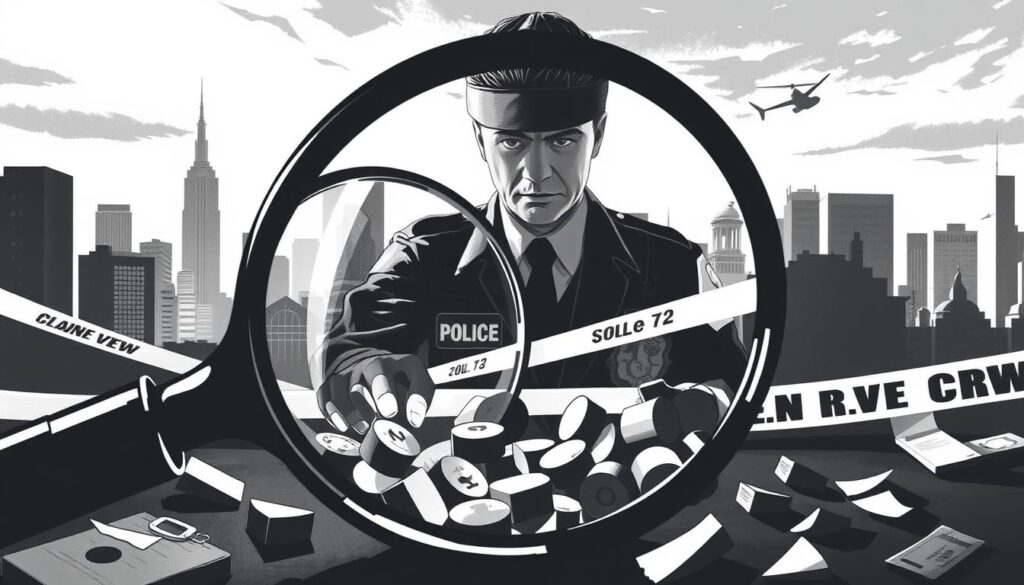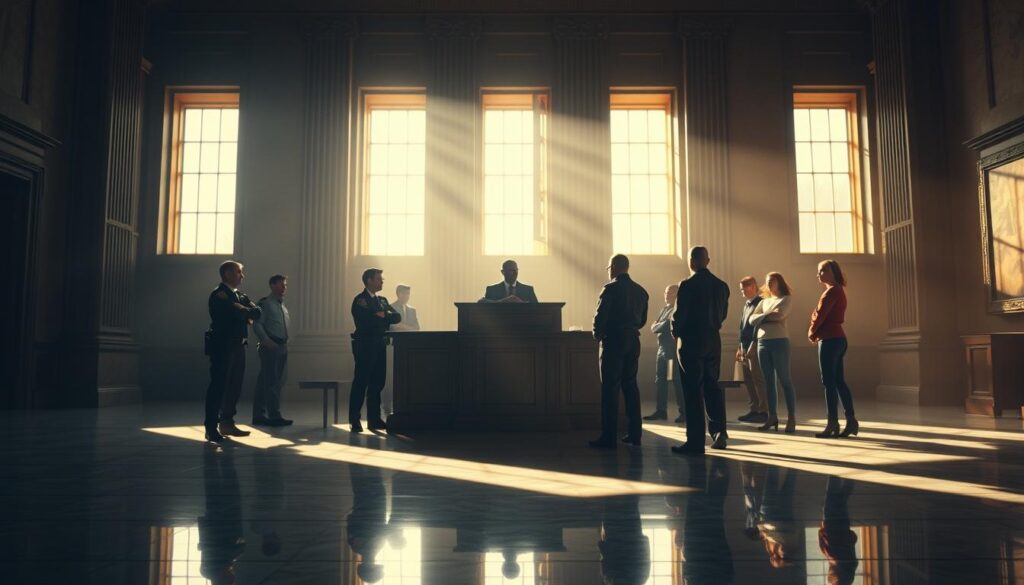Table of Contents
In Canada, the plain view doctrine plays a crucial role in shaping law enforcement practices and privacy rights. This legal principle allows officers to seize evidence that is clearly visible without the need for a warrant, making it a significant tool in criminal investigations. However, its application is not without controversy, as it raises important questions about privacy rights and the limits of police authority.
The doctrine is deeply rooted in lawful search procedures and statutory interpretations. Expert legal insights from Sohi Law Group emphasize that while the plain view doctrine can be a powerful instrument for law enforcement, it must be applied with careful consideration of individual rights. For instance, the Supreme Court of Canada has highlighted that preventing breaches of the peace is a core police duty, but arrests made for preventive purposes require strict scrutiny.
Understanding the nuances of the plain view doctrine is essential for both legal professionals and individuals seeking to protect their rights. Sohi Law Group, with their extensive experience in Canadian law, offers expert guidance on these matters. If you have questions or need legal advice, you can reach them at 833-877-9797.
Introduction to the Plain View Doctrine in Canada
The plain view doctrine is a legal principle that allows law enforcement officers to seize evidence that is clearly visible without needing a warrant. This doctrine is crucial in criminal investigations as it helps police gather evidence efficiently while respecting privacy rights.
Overview and Importance
The doctrine is essential because it enables officers to act swiftly when they encounter evidence in plain sight. For instance, during a lawful search, if an officer sees illegal items, they can seize them immediately. This not only aids in investigations but also upholds the integrity of the legal process.
Relevance in Modern Law Enforcement
Today, the doctrine remains vital. It provides clear guidelines for seizures, ensuring that police actions are lawful and respect individual rights. This balance is key in modern policing, where technology and evolving privacy expectations require precise legal frameworks.
| Aspect | Details | Importance |
|---|---|---|
| Lawful Presence | Officers must be in a legal location when evidence is found. | Ensures searches are conducted lawfully, preventing unauthorized access. |
| Immediate Apparent Nature | Evidence must clearly indicate criminal activity. | Helps officers make quick, informed decisions without warrants. |
| Inadvertent Discovery | Evidence must be found unintentionally. | Prevents exploratory searches, protecting individual privacy. |
For further insights or legal advice, contact Sohi Law Group at 833-877-9797.
Historical Context and Legal Evolution
The plain view doctrine has evolved significantly over time, shaped by key judicial decisions that have clarified its application and limits. Understanding this historical context is crucial for grasping how the doctrine operates today.
Landmark Cases and Precedents
The doctrine’s legal framework has been influenced by several landmark cases. One such case is R. v. Tessling, which established important principles regarding the seizure of evidence in plain view. This case highlighted the necessity of lawful presence and the inadvertent discovery of evidence, setting a precedent for future applications of the doctrine.
Another significant case, R. v. Boersma, further refined the requirements for officers to seize evidence without a warrant. These rulings underscored the balance between effective law enforcement and the protection of individual rights, ensuring that the doctrine is applied judiciously.
| Case | Key Principle | Impact |
|---|---|---|
| R. v. Tessling | Lawful presence and inadvertent discovery | Set clear guidelines for evidence seizure |
| R. v. Boersma | Proper procedure for warrantless seizures | Protected individual rights while enabling police efficiency |
These landmark cases demonstrate how the plain view doctrine has been refined over time, ensuring it remains a vital yet balanced tool in Canadian law enforcement. For more information on legal implications, visit Sohi Law Group.
Key Elements of the Plain View Doctrine
The plain view doctrine is rooted in clear legal standards that balance law enforcement needs with individual rights. These standards ensure that searches and seizures are conducted lawfully while respecting privacy expectations.
Lawful Position and Initial Intrusion
For evidence to be seized under this doctrine, officers must be in a lawful location. This means they must have legal authority to be where the evidence is found. The initial intrusion, whether into a physical space or digital environment, must also be justified. As emphasized by Sohi Law Group, officers cannot exploit unlawful access to gather evidence.
Inadvertent Discovery and Evidentiary Standards
The discovery of evidence must be inadvertent, meaning officers cannot knowingly search for it without a warrant. The evidence must also be immediately apparent, leaving no doubt about its criminal nature. Evidentiary standards require that the connection between the item and criminal activity be clear. This ensures that seizures are not based on speculation but on concrete, observable facts.
| Element | Description | Importance |
|---|---|---|
| Lawful Presence | Officers must be legally authorized to be at the location. | Prevents unauthorized searches and ensures legal compliance. |
| Inadvertent Discovery | Evidence must be found unintentionally during lawful activities. | Protects against exploratory searches, upholding privacy rights. |
| Immediate Apparent Nature | Evidence must clearly indicate criminal activity. | Allows officers to act swiftly without warrants, aiding investigations. |
| Evidentiary Standards | Clear connection between evidence and criminal activity. | Ensures seizures are based on observable facts, not speculation. |
These elements are closely tied to constitutional mandates, particularly Section 8 of the Charter, which safeguards against unreasonable search and seizure. By adhering to these standards, the doctrine maintains the delicate balance between effective law enforcement and the protection of individual rights.

Understanding plain view doctrine canada
The plain view doctrine is a legal principle that allows law enforcement officers to seize evidence without a warrant if it is clearly visible. This principle is crucial in criminal investigations as it enables police to act swiftly while respecting privacy rights. However, its application is not without debate, raising important questions about individual rights and police authority.
In Canada, the doctrine is applied when officers are in a lawful location and discover evidence unintentionally. The evidence must clearly indicate criminal activity, allowing officers to seize it without further investigation. This balance between effective law enforcement and individual rights is key in modern policing.
Courts have refined the doctrine through landmark cases like R. v. Gill, where the British Columbia Court of Appeal upheld the seizure of cocaine discovered during an arrest. This case emphasized that evidence must be in plain view and discovered inadvertently, ensuring officers do not conduct exploratory searches without a warrant.
The doctrine also protects individual rights under Section 8 of the Charter, which safeguards against unreasonable searches. Law enforcement must have reasonable grounds to believe the seized items are evidence of a crime, ensuring seizures are based on observable facts, not speculation.
For more information on legal implications or if you face manslaughter charges, consult legal experts like Sohi Law Group. Their guidance can help navigate complex legal scenarios, ensuring your rights are protected.
Legal Insights and Applications
The practical applications of the plain view doctrine offer valuable insights into its role in modern law enforcement. This principle streamlines evidence seizure, allowing officers to act without warrants in specific circumstances. However, its use must adhere to strict legal standards to prevent misuse and protect individual rights.
Seizure of Evidence and Warrant Requirements
Law enforcement can seize evidence under the plain view doctrine if it is clearly visible and discovered inadvertently during lawful activities. This eliminates the need for a warrant, enabling police to respond swiftly. However, procedural safeguards are essential to ensure these seizures are conducted lawfully and without overstepping privacy boundaries.
Application During Technological Investigations
Advances in technology have expanded the doctrine’s scope to digital investigations. For example, officers may seize digital evidence if it is readily apparent on a device during a lawful search. Courts have upheld such seizures, provided they meet the necessary legal criteria. This adaptation ensures the doctrine remains effective in contemporary investigative contexts.
| Aspect | Traditional Context | Digital Context |
|---|---|---|
| Lawful Presence | Officers must be legally present at the search location. | Access to digital devices must be authorized, such as through a warrant or consent. |
| Evidence Discovery | Evidence is found in plain sight during a physical search. | Evidence is found in plain sight on a digital device, such as files in an unlocked folder. |
| Immediate Apparent Nature | Evidence clearly indicates criminal activity. | Digital evidence, like illegal files, is immediately recognizable as criminal. |
For guidance on navigating the complexities of evidence seizure, consult legal experts like Sohi Law Group, who provide expertise in such matters.

Balancing Privacy Rights Against Law Enforcement Interests
Striking the right balance between privacy rights and law enforcement obligations is a cornerstone of legal systems. In Canada, this balance is particularly evident in how the plain view doctrine is applied, as highlighted by expert legal insights from Sohi Law Group.
Reasonable Expectation of Privacy
A reasonable expectation of privacy is a critical factor in determining the legality of searches and seizures. Under Canadian law, individuals have varying levels of privacy expectations depending on the context. For instance, there is a higher expectation of privacy in private residences compared to public spaces. Law enforcement must respect these expectations while carrying out their duties.
- Public areas generally offer less privacy protection.
- Private vehicles, while mobile, still afford privacy rights.
- Homes are entitled to the highest level of privacy protection.
Impact on Charter Rights
Section 8 of the Canadian Charter of Rights and Freedoms explicitly protects individuals against unreasonable search and seizure. The application of the plain view doctrine must align with this constitutional safeguard. Judicial oversight plays a pivotal role in ensuring this balance is maintained.
A landmark case, such as R. v. Stairs, underscores the complexities of this balance. The Supreme Court of Canada ruled that warrantless searches are generally presumed unreasonable but can be justified under specific conditions related to safety and law enforcement objectives. This decision highlights the delicate interplay between privacy rights and police duties.

For more information on how privacy rights are protected in criminal investigations, contact Sohi Law Group at 833-877-9797.
Implications for Police Search and Seizure Practices
Police search and seizure practices are shaped by a delicate balance between effective law enforcement and individual privacy rights. Understanding the legal framework that governs these practices is crucial for both law enforcement agencies and the public. Expert legal insights from Sohi Law Group emphasize the importance of adhering to procedural obligations while respecting individual rights.
Lawful Search Techniques on Private and Public Premises
Law enforcement officers employ various techniques to conduct searches on both private and public properties. On private premises, officers must typically obtain a warrant unless specific exceptions apply, such as exigent circumstances. In public spaces, the standards for searches are less stringent, but officers must still adhere to legal guidelines to avoid unreasonable searches.
One common technique involves the seizure of items found in plain view during a lawful search. For example, if an officer is lawfully present in a private residence and notices a suspicious object in plain sight, they may seize it if it clearly indicates criminal activity. This approach streamlines the investigative process while respecting privacy rights.
In drug-related investigations, the discovery of items in plain view is particularly significant. If an officer inadvertently discovers illegal substances during a lawful search, they can seize the evidence without a warrant. This practice is supported by legal precedents such as R. v. Askov, which established that officers must be lawfully present and that the evidence must be immediately apparent.
The reasonable expectation of privacy varies depending on the context. In private residences, individuals have a high expectation of privacy, whereas in public areas, this expectation is significantly lower. Officers must consider these standards when conducting searches to ensure they are lawful and reasonable.
For instance, searching a vehicle during a traffic stop is generally permissible if officers have reasonable grounds to believe illegal items are present. However, entering a home without a warrant or consent typically violates privacy rights unless exigent circumstances exist. These distinctions highlight the complexities of search and seizure laws.
For further guidance on search and seizure practices, consult legal experts like Sohi Law Group. Their expertise can help navigate the intricacies of these legal standards, ensuring that individual rights are protected while upholding the rule of law.

Investigative Techniques and Technological Considerations
Advancements in technology have significantly influenced modern investigative practices, particularly in how law enforcement gathers evidence. These tools, while enhancing efficiency, also raise important legal questions about privacy and procedural compliance.
Use of FLIR and Other Sensor Technologies
Forward-Looking Infrared (FLIR) technology and other sensor devices allow officers to detect activities that may not be visible to the naked eye. These tools are often used to monitor suspicious behavior without physical intrusion, thus respecting individuals’ privacy expectations while aiding investigations.
For instance, FLIR can detect heat signatures, which might indicate illegal activities like drug manufacturing. However, courts have emphasized that such use must comply with legal standards to avoid unconstitutional searches. As noted by legal experts, the deployment of such technologies must be proportionate to the suspected offense.
Digital Devices and Electronic Evidence
Digital devices have become a focal point in contemporary investigations. Under the plain view doctrine, officers can seize electronic evidence if it is readily accessible and clearly indicates criminal activity. This approach streamlines investigations but also sparks debates about digital privacy rights.
| Aspect | Traditional Context | Digital Context |
|---|---|---|
| Lawful Presence | Physical presence at a legal location. | Authorized access to digital devices, often via warrants. |
| Evidence Discovery | Physical items in plain sight. | Digital files accessible without encryption. |
| Immediate Apparent Nature | Physical evidence of criminal activity. | Digital files clearly indicating illegal content. |
These technological advancements have reshaped how evidence is discovered and seized, necessitating a balanced approach that respects privacy while upholding the law.

Case Studies and Precedents in Plain View Applications
The plain view doctrine has been shaped by numerous judicial decisions, each contributing to its evolution and application. These cases provide valuable insights into how courts interpret and apply the doctrine in various contexts.
Examples from R. v. Tessling and Related Cases
R. v. Tessling stands as a landmark case in Canadian legal history, establishing foundational principles for the plain view doctrine. The Supreme Court ruled that officers must be lawfully present and that evidence must be discovered inadvertently. This case set a precedent for balancing police efficiency with individual privacy rights.
In R. v. Boersma, the court further clarified the requirements for warrantless seizures. The decision emphasized the need for clear criminal activity indicators, ensuring that seizures are based on observable facts rather than speculation.
Recent Developments in Digital Evidence Searches
With the rise of technology, the plain view doctrine has extended into digital realms. Courts now address how the doctrine applies to electronic evidence, such as files on digital devices. A recent decision highlighted that digital evidence in plain sight, like unlocked files, can be seized without a warrant, provided lawful access is established.
Expert analysis from Sohi Law Group notes that these developments maintain the doctrine’s relevance in modern investigations while respecting privacy expectations. For more on digital evidence, visit Canadian Justice Cases.

These cases illustrate the doctrine’s adaptability, ensuring it remains a vital tool in law enforcement while safeguarding individual rights. For specialized legal advice on evidence seizure, consult Sohi Law Group, experts in Canadian legal matters.
Constitutional Analysis and Section 8 Concerns
Section 8 of the Canadian Charter of Rights and Freedoms is a cornerstone of privacy protection, safeguarding individuals against unreasonable search and seizure. This constitutional right is pivotal in balancing law enforcement efficiency with individual privacy. As emphasized by the Supreme Court in Hunter v. Southam, a search without a warrant is presumed unreasonable unless the Crown can justify it.
Search and Seizure Reasonableness Test
The reasonableness of a search is determined by assessing both the subjective and objective expectations of privacy. Subjective expectation focuses on the individual’s belief in privacy, while objective expectation evaluates whether a reasonable person would expect privacy in the same circumstances. For instance, in R. v. Edwards, the court ruled that an individual without control over a space may not have a reasonable privacy expectation.
Subjective vs. Objective Privacy Expectations
Objective expectations often prevail in legal decisions. In R. v. AM, the Supreme Court recognized students’ privacy rights in their backpacks at school, highlighting the importance of context. This balance ensures that police power is exercised judiciously, respecting individual rights while upholding the law.

For insights into Section 8 implications, consult experts like Sohi Law Group, who provide guidance on navigating these complex legal standards.
Practical Guidance from Sohi Law Group
Expert legal guidance is essential for navigating the complexities of the plain view doctrine and its applications in modern law enforcement. Sohi Law Group offers specialized counsel, ensuring that individuals and professionals understand their rights and obligations within the framework of Canadian law.
Expert Legal Insights
Sohi Law Group provides clear, step-by-step guidance on handling cases involving the plain view doctrine. Their legal experts emphasize the importance of understanding the lawful presence of officers, the inadvertent discovery of evidence, and the immediate apparent nature of criminal activity.
- Understand your rights during searches and seizures.
- Know the legal standards for evidence seizure.
- Learn how to document interactions with law enforcement.
Their team also shares practical tips for legal professionals, such as reviewing case precedents and staying updated on Supreme Court rulings that shape the doctrine’s application.
Contact Information: Call 8338779797
For personalized legal advice or to discuss your case, contact Sohi Law Group at 833-877-9797. Their commitment to making legal services accessible and understandable ensures that you receive the support you need to navigate complex legal scenarios.
Let Sohi Law Group help you protect your rights and navigate the intricacies of the plain view doctrine. Call today for a consultation.
| Aspect | Traditional Context | Digital Context |
|---|---|---|
| Lawful Presence | Physical presence at a legal location. | Authorized access to digital devices, often via warrants. |
| Evidence Discovery | Physical items in plain sight. | Digital files accessible without encryption. |
| Immediate Apparent Nature | Physical evidence of criminal activity. | Digital files clearly indicating illegal content. |
Conclusion
In conclusion, the plain view doctrine serves as a cornerstone in Canadian law enforcement, allowing officers to seize evidence in specific circumstances without a warrant. This legal principle requires lawful presence, inadvertent discovery, and immediate apparent criminal activity, ensuring a balance between effective investigations and individual privacy rights.
Landmark cases like R. v. Tessling and R. v. Boersma have shaped the doctrine, emphasizing the need for clear guidelines. These rulings ensure that police actions remain lawful while respecting constitutional rights, particularly under Section 8 of the Charter. Technological advancements have further expanded the doctrine’s application, adapting to digital evidence and modern investigative practices.
For those navigating the complexities of evidence seizure or facing legal challenges, seeking expert advice is crucial. Contact Sohi Law Group at 833-877-9797 for specialized guidance. Their expertise ensures that your rights are upheld while adhering to the intricacies of Canadian law.





No comment